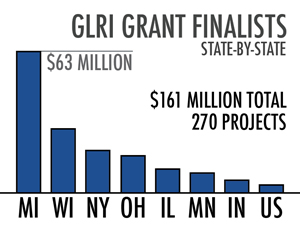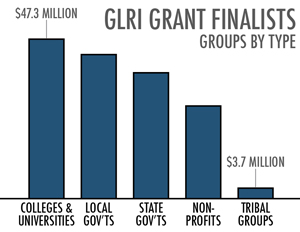I spent my Memorial Day weekend fishing, swimming and eating, but I didn’t enjoy one minute of it. I was just going through the motions, eager to get back to work so I could pore over the EPA’s list of 270 Great Lakes Restoration Initiative grant finalists released last week.
The grants cover $161 million — a third of the $475 million GLRI — worth of projects like beach monitoring, habitat restoration and environmental education. But the checks aren’t in the mail yet: finalists still have to submit one more non-competitive application before the projects are funded and work begins this summer.
Check out the complete list of finalists here, or download the list in Excel spreadsheet format here. If there’s anything that you’re especially happy to see — or that looks like a big waste of money — let us know in the comments.
The 270 finalists were trimmed from a list of 1,057 proposals requesting $946 million. The potential grant winners are grouped by state and group type below. Dollar amounts are rounded to the lowest 100,000.
State-by-state

Click to enlarge.
Michigan: $63 million for 99 projects. That includes the biggest grant of the bunch: $10 million for Central Michigan University’s coastal wetlands monitoring project. Another $14.5 million could go to the Michigan Department of Natural Resources and Environment for 29 projects, which is more projects than any other group or agency.
Wisconsin: $29 million for 50 projects. Wisconsin’s biggest grant is for the Brown County Port and Solid Waste Department’s $2 million project to environmentally cap Renard Island. The Milwaukee Metropolitan Sewerage District is in line for $3.7 million to cover seven projects, including $1.6 million for habitat restoration on the Kinnickinnic River.
New York: $19.6 million for 33 projects. Clarkson University could get the second biggest overall grant: $6.5 million for a fish monitoring and surveillance program. The St. Regis Mohawk Tribe could get $1.9 million for work on the Massena-Akwesasne Area of Concern and restoring lake sturgeon.
Ohio: $17.2 million for 28 projects, including two $1.5 million habitat restoration projects in the Cuyahoga Area of Concern led by the Cuyahoga County Engineer’s Office, and another $1.5 million habitat restoration project in the Ashtabula River Area of Concern led by the Ohio Environmental Protection Agency.
Illinois: $11.4 million for 25 projects, including $2 million for the University of Illinois at Chicago’s Great Lakes Sediment Surveillance Program, and $300,000 for an Illinois Department of Natural Resources project called “Electric Barrier Defensive Removal of Asian Carp.”
Minnesota: $9.7 million for 14 projects, including $3.9 million for five University of Minnesota projects. Those five projects include moose habitat restoration and avian botulism management. The Minnesota Pollution Control Agency could collect $1.7 million for three restoration projects on Amity Creek and the Flute Reed and St. Louis rivers.
Indiana: $6.3 million for 11 projects, including $1.3 million for the Indiana Department of Environmental Management to restore habitat in the Grand Calumet Area of Concern. The University of Notre Dame could pick up nearly $1 million for the environmental DNA surveillance that’s been important in the Asian carp issue and another $1 million for preventing environmental invasions from the live animal trade.
Pennsylvania: $1.2 million for 4 projects, including $530,000 for Pennsylvania Sea Grant program for disposal of pharmaceuticals and personal care products
Groups from five states outside of the basin could also get a slice of the pie: $3 million could cover five projects from Iowa, Maryland, New Jersey, Rhode Island and Vermont. The projects include a University of Iowa investigation of Chicago as a source of air toxics to Lake Michigan and Montclair State University’s work on ultrasound technology for Great Lakes ballast water treatment.
Kinds of groups

Click to enlarge.
Schools: $47.3 million for 61 projects. Includes colleges and universities. After Central Michigan University (which has one $10 million project) and Clarkson University (one $6.5 million project), the University of Minnesota could collect the most money, with $3.9 million for five projects. The University of Wisconsin system is in line for $4.9 million, but that’s spread over four universities and their extension program.
Schools have the highest dollars-per-grant average, at around $775,000. But if you eliminate the $16.5 million tied up in the two Central Michigan and Clarkson grants as an outlier, the average drops to $522,000, which is third behind local governments and non-profits.
Local governments: $42.7 million for 68 projects. Includes county, city, and village governments, and governmental institutions like conservation districts and regional planning commissions. Grants average $627,000 each.
State governments: $37.5 million for 78 projects. Includes state health, education, agriculture, environmental, and natural resources departments. The biggest of these grants — $1.8 million for enhancing Wisconsin’s fish consumption advisory program — could go to the state’s Department of Health Services. Grants average $480,000 each.
Non-Profits: $27.8 million for 52 projects. Includes national groups like Ducks Unlimited and the Nature Conservancy and local groups like Groundwork Milwaukee and the Kalamazoo Nature Center. Grants average $534,000 each.
Tribes: $3.7 million for 8 projects. Grants to tribes have the lowest dollar average at around $470,000.
Editors note: Great Lakes Echo is a finalist for part of an $83,000 Great Lakes Restoration Initiative Grant to Michigan State University. It would support news coverage of the nearshore environment.
Pingback: Media roundup: Wildlife Service and EPA talk GLRI grants | Great Lakes Echo
Environmentalist should take note the President has stated their should be no doubt about it the government has been calling the shots from the beginning. As the news report, that dispersant used for days on end underwater, at the well head was an experiment never tried before underwater, was the Federal government even watching to see what the results of this would be or were they just wanting to keep the scope of the leak hidden. Now because of this, the environmental effects will take decades to understand and permanent harm to our food chain probably has taken place. With the administrations military ballast water plan following an international organization of business interest, (IMO) once these plumes reach shipping lanes it will be dispersed around the world as the IMO policy of dilution being the solution to pollution, with their spit and swish ocean flushes is what our president has planned for our regulations. Hopefully the ships entering our Great Lakes after ocean flushing will now be checked for oil as well as invasive s.
I couldn’t agree more with Mr. Wilson’s assessment of the grant program.
I recall Cameron Davis saying that these need to be projects that “move the needle” toward restoration. I’m not sure I see that in many of these projects. Monitoring, studying, and reviewing do not move the needle. “Implementation” of projects moves the needle!
In addition, there were repeated calls for projects focused on Areas of Concern. Yet, when I look at the final list of grants – there are certainly a large number of them that are very far from, and have no impact on, AOCs.
There are a number of really good projects. But overall, I am disappointed with the vast majority of them – and the process that got us here.
Thank you for the great article and for keeping tabs on this process.
Thanks Jeff for digging deeper, much appreciated.
The Initiative is what it is, which is the Bush Administration’s program that was never funded but left on the shelf, then quickly grabbed and promoted because it was readily available when it became apparent that the Obama administration was going to come through with federal dollars.
Critical reviewers in the media, including the Milwaukee Journal Sentinel, Toledo Blade, and the Echo questioned the plan’s focus and thought it may be a mile wide and an inch deep. Plus, it’s basically silent on regulation and enforcement.
But here it comes so we’ll have to make the best of it and hope that on the next go round more focus and attention will be given to action items vs. passive ones.
And yes, trust is extended, as long as you report what you see and are not afraid to tell the truth to the folks in power, and who hold the purse strings.
Excellent work by the Echo.
Gary, there has definitely been EPA double talk on the GLRI from the beginning. Despite Davis’s anti-monitoring talk, the pot of money for the “Accountability, Monitoring, Evaluation, Communication, and Partnerships” category is $5 million greater than the invasive species pot.
Davis said something pretty similar to what he told the Bay City Times at the GLRI public comment meeting in East Lansing this past August, but there he gave it a pretty heavy qualification:
“The time for studying is gone. We need action. Now, that doesn’t mean that there isn’t a place for studying and monitoring and surveys and modeling. But where they are gonna happen, they need to be tied directly to action.”
Hear it for yourself here: http://greatlakesecho.org/2009/08/03/michigan-residents-discuss-great-lakes-restoration-initiative-urge-for-continued-public-input/
To answer you question, I see “monitor” 11 times, “model” nine times, “study” or “studies” seven times and “review” once.
But I also see some variation of “restoration” 62 times.
The bottom line is that you’re right — individual projects need to be scrutinized to see if they’ll ever be tied to action. That’s something that I am working on and would love to get Echo readers involved with.
In the meantime, my paycheck comes from the John S. and James L. Knight Foundation, so hopefully you’ll trust me as an independent reviewer.
Jeff,
Thanks for your work on this.
Last August Great Lakes EPA Advisor Cameron Davis told the Bay City Times the following about selection criteria.
“The kinds of projects that we are looking for are projects that are going to make a real difference in bringing the ecology of the Great Lakes back to life, and in short order,” he said.
“We’re really looking for action-oriented projects and especially those where a plan may already exist so that we don’t have to wait for more studies and more surveys and monitoring to come — things where we know what the problem is, we know what the solution is, and we’re ready to go.”
If you go back and look at the descriptions of the selected projects, how many times do you see words like “monitor and review?”
The largest grant, $10 million to CMU is to “monitor” wetlands.
I suspect it’s a great project but there is unlikely to be an actionable result in the near term.
As Dave Dempsey said on the Great Lakes Town Hall, there’s some good stuff in the EPA’s finalist list. But it needs to be examined more closely.
Preferably by an independent reviewer — ie. someone without a financial stake in the process.
Gary Wilson
n.b. Full disclosure – I’m the board chair of a not-for-profit that was not selected. I did however post my comments on the Town Hall prior to knowing that and would have likely had the same questions/comments anyway.